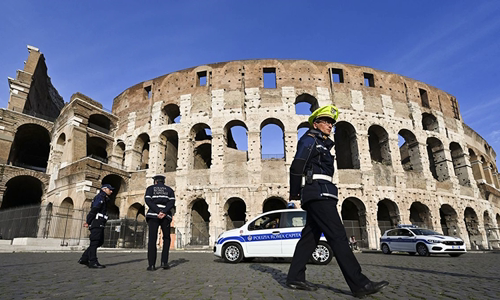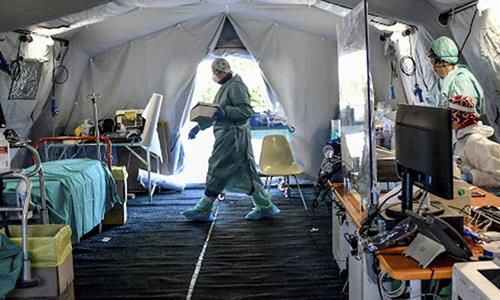Three weeks ago, Italy remained calm before Covid-19 when there were only three infections, many thought the blockade was the story of the 14th century.
Now, this European nation is becoming the second largest Covid-19 hot spot in the world after mainland China, with more than 12,000 infections and at least 827 deaths, far higher than the other two hotspots. is Iran and South Korea, as well as all other European countries.

Police patrol outside the Colosseum in Rome, Lazio region after a nationwide blockade on March 9 Photo: AFP
In order to prevent Covid-19 from further intensifying, Prime Minister Giuseppe Conte introduced a series of drastic measures never seen in the country in modern times: nationwide blockade at least until April 3, even Even the organization of funerals and weddings is prohibited.
An important reason for this drastic measure was that Covid-19 "engulfed" Italy's health system, especially in the north, where the outbreak was the strongest. More than 80% of the beds in the Lombardy region are reserved for nCoV-infected patients, the intensive care unit is always overloaded, many surgeries do not need to be canceled to make room for nCoV-infected people. Stories about Italian doctors having to choose patients for treatment because of the overload are shared a lot on social networks.
But behind the official data on Covid-19 is a more serious crisis nationwide. Unintended losses due to the overloaded health system are even greater than the number of deaths due to nCoV is increasing every day. Pregnant women and infants, cancer patients, HIV or children who need a vaccine are now less likely to receive necessary medical care.
"Most health care systems are streamlined, so when the number of patients increases abnormally, the resources are quickly depleted. If you respond too slowly, you'll get in trouble," said Richard Neher, researcher at the University of Basel, Switzerland, specializing in the Covid-19 model that puts pressure on the health system.
"It is very clear that if the spread of nCoV does not slow down, the health systems will be overwhelmed," he added.
Earlier in February, Italy recorded only a few cases of nCoV. But as of February 23, Italian officials said there were 76 cases. Two days later, this number jumped to 229. Since then, the number of deaths and nCoV infections in Italy has increased exponentially and many cases have been reported in Nigeria, Switzerland, Brazil and Spain. Originating from this European country.
The soaring number of nCoV infections has caused Italian officials to rush to take drastic measures not to be outdone by China to control the virus. In northern Italy, many sporting, cultural and religious events were canceled and universities closed. Anyone who voluntarily comes and leaves blockade towns in Lombardy faces a penalty.
It is not clear why Covid-19 in Italy broke out faster than other European countries, but several hypotheses have been proposed. One theory is that the number of cases increased rapidly at the time because the Lombardy region conducted a mass testing campaign, while many other countries were delayed in detecting cases.
Another theory is that Covid-19 spread in the hospital system before doctors discovered, making the outbreak more severe. About 10% of health workers in Lombardy 5% across the country are infected with nCoV.
There is also a theory that the aging population is the burden of Italy in the fight against Covid-19, because this is the most vulnerable to the nCoV attack. Along with the rapid increase in cases, the aging population is a test of the country's health system.

Temporary emergency room at a hospital in Brescia, northern Italy Photo: AP.
"We found that up to 10% of positive cases for nCoV require treatment in the intensive care unit," Italian doctors warned in a letter. "We want to convey a message that: Get ready!".
What is happening in Italy will likely be the future scenario of any other Western nation. The story of Lombardy, one of Europe's richest regions, shows that Covid-19 could lead to a full-blown crisis only after a night of flare-ups if officials are too prepared and react too slowly. Many believe that the US will soon be confronted with a similar scenario.
Testing for nCoV in the US so far has been slow, but many experts expect the number of cases to rise even as health officials begin testing for nCoV on a wider scale.
The predictions of the outbreak in Washington state, where 179 cases are recorded, may explain this. According to Trevor Bedford, an expert at Fred Hutchinson Cancer Research Center, Covid-19 could spread in Seattle from mid-January, long before the first case was reported.
As of March 10, he and his colleagues estimated there were about 1,100 cases in Seattle alone. "Seattle data shows that infection in the community is undetected. It shows us that Covid-19 may appear in people who never thought they were infected," said Emma Hodcroft, associate of Bedford, said.
This is only a prediction in Washington state. The ability to test for nCoV throughout the United States is limited. Until March 8, the US conducted tests for 1,700 people, too small compared to 50,000 in Italy and 23,000 in the UK.
A study of the size of Covid-19 in the US estimated that there were 9,484 nCoV infections in the US as of 1/3, nearly 10 times higher than the more than 1,000 reported cases.
"Looking at all the evidence, analyzing, I believe we still have a lot of undiscovered cases. They are silently infecting communities, across regions and countries," said Lawrence Gostin, expert. Global at Georgetown University, said.
If the number of nCoV infections is doubling every week like in Italy right now, the US will soon face the crisis.
"I think what happened in Italy showed that if the virus had a chance of spreading without being detected, it would be very difficult to overcome the consequences. The defeat of Italy is a wake-up call to the part. rest of Europe and America, "Hodcroft said.



 MelonieMoore
MelonieMoore







